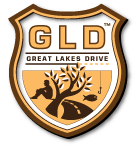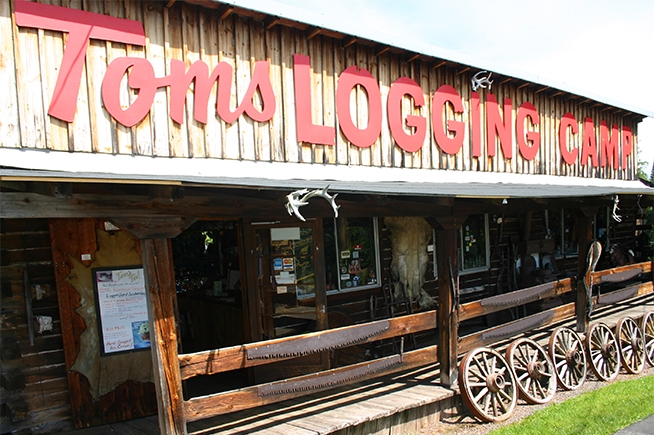Tom’s Logging Camp
Tom’s Logging Camp
french RIver mn
Books have been written, stories told, and motion pictures made of the Historic Logging Camp days when rugged men and tough animals fought the bitter cold and heavy snow to harvest the mighty forests of Northern Minnesota. Today the camps and horses and most of the men are gone. Machines, power saws, trucks, etc. have taken their place. An era has ended. We have restored the past for your pleasure and education in Tom’s Logging Camp. Our camp offers an authentic duplicate of a typical Northern Minnesota Logging Camp, with all the building and articles, original tools and equipment from that by-gone era.
Tom’s Historic Logging Camp and Old Northwest Company Trading Post is located in the heavily wooded area of lofty spruce, balsam, birch and pine, just 16 miles northeast of downtown Duluth or 2 miles southwest of Knife River, following the Scenic North Shore Drive of Lake Superior Scenic 61. We have duplicated an old logging camp with a Horse Barn, Blacksmith Shop, Harness Shop, Shoe Shop, Horseshoeing Stall, Bunkhouse, Cook Shanty and Finnish Sauna, each building authentically equipped. Ring the Dinner Bell. Visit our Gravity House. Children especially enjoy feeding the llamas, pygmy goats, and rainbow trout.
History of Northshore Logging – See It At Tom’s!
Northern Minnesota is essentially covered with one large forest. Although the potential for a lumber industry was recognized early in the course of European settlement, the distances that it would have to be shipped made it uneconomical. However, in the 1880s Michigan exhausted most of its forests. With the new branches of the Northern Pacific Railroad running through Duluth, lumber industries moved into Wisconsin and Minnesota. Duluth and Superior began milling large amounts of lumber to be shipped by rail; but in the 1890s, Duluth began shipping logs out across the lake to the east. Lumberjacks in turn began moving north and rafting logs down to Duluth along the lake from Knife River, Castle Danger, Grand Marais, and Pigeon River.
In 1898, the Alger-Smith Lumber Company began cutting the virgin pine forests of Northeastern Minnesota. A logging camp was set up on the shores of a lake the loggers called Nipisiquit, an Indian name from a tribe in New Brunswick, Canada, the logger’s native country. They took the Algonquin names for New Brunswick landmarks and gave them to the lakes in Tettegouche.
In 1910, after removing most of the Norway and white pine, the logging company sold the camp and surrounding acreage to the “Tettegouche Club,” a group of businessmen from Duluth who used the area as a fishing camp and retreat. One of its members, Clement Quinn, bought the others out in 1921 and continued to act as protector for the area until 1971 when Quinn sold Tettegouche to the deLaittres family. The deLaittres continued Quinn’s tradition of stewardship for the land, beginning negotiations several years later for the preservation of Tettegouche as a state park. During these years, the Nature Conservancy, a private land conservation organization, played a vital role (along with other concerned individuals and groups) in the transfer of ownership. Finally, on June 29, 1979, legislation was enacted establishing Tettegouche as a state park.
Because of conservation efforts, most of the forests along the North Shore are now protected from deforestation, essentially ending the lumber industry. Duluth had only one remaining lumber mill by 1925, but it still receives shipments of lumber which are used in its paper mills.
Phone Number (218) 525-4120
Tom’s Historic Logging Camp
Content the property of Tom’s Logging Camp and Wikipedia.
IMPORTANT NOTE: Great Lakes Drive, affiliates, and site resources are not responsible for any incidents attributed to the use of this information. All information provided on this site should be considered a simple bit of information that informs the average individual on activities or available lodging that others have participated in, and in many cases warns them of dangerous aspects of a location, and should not be considered a promotion for taking part in the activity or a recommendation to use, stay, or support. Some of these pages represent extremely dangerous activities and should not be considered by individuals and families as normal activities. Many of the links provide information contributed by professionals or adrenaline junkies and are meant only as interesting points. Other information would probably never be heard about and represents wonderful historic facts and fiction about places that have disappeared. All activities from driving a car to entering the water can be hazardous and should be taken on at your own risk. Take responsibility for your actions and be very careful when exploring this wonderful fast land that is available to us all. Ads on the site may be from awesome companies but for legal reasons they do not necessarily represent the beliefs or receive the support of GreatLakesDrive.com. By reading the information on a page, and/or clicking on any of the links, you agree to take full responsibility in the result. Drive Safely! Stay on the path if you are concerned about the results of stepping off the edge. Discover a wonderful place right in your own backyard! You will never forget it.


